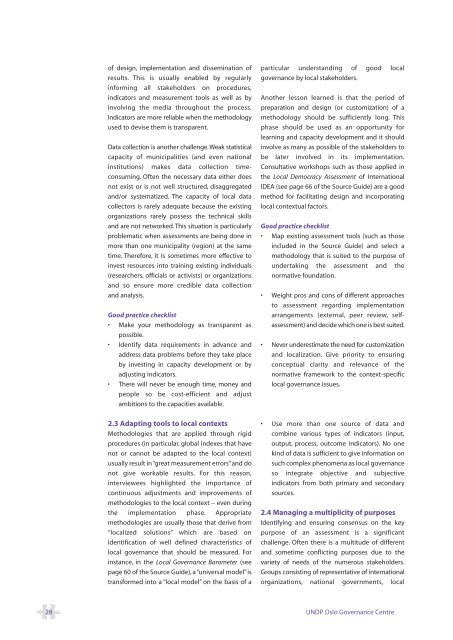A Users' Guide to Measuring Local Governance
A Users' Guide to Measuring Local Governance
A Users' Guide to Measuring Local Governance
You also want an ePaper? Increase the reach of your titles
YUMPU automatically turns print PDFs into web optimized ePapers that Google loves.
of design, implementation and dissemination of<br />
results. This is usually enabled by regularly<br />
informing all stakeholders on procedures,<br />
indica<strong>to</strong>rs and measurement <strong>to</strong>ols as well as by<br />
involving the media throughout the process.<br />
Indica<strong>to</strong>rs are more reliable when the methodology<br />
used <strong>to</strong> devise them is transparent.<br />
Data collection is another challenge. Weak statistical<br />
capacity of municipalities (and even national<br />
institutions) makes data collection timeconsuming.<br />
Often the necessary data either does<br />
not exist or is not well structured, disaggregated<br />
and/or systematized. The capacity of local data<br />
collec<strong>to</strong>rs is rarely adequate because the existing<br />
organizations rarely possess the technical skills<br />
and are not networked. This situation is particularly<br />
problematic when assessments are being done in<br />
more than one municipality (region) at the same<br />
time. Therefore, it is sometimes more effective <strong>to</strong><br />
invest resources in<strong>to</strong> training existing individuals<br />
(researchers, officials or activists) or organizations<br />
and so ensure more credible data collection<br />
and analysis.<br />
Good practice checklist<br />
• Make your methodology as transparent as<br />
possible.<br />
• Identify data requirements in advance and<br />
address data problems before they take place<br />
by investing in capacity development or by<br />
adjusting indica<strong>to</strong>rs.<br />
• There will never be enough time, money and<br />
people so be cost-efficient and adjust<br />
ambitions <strong>to</strong> the capacities available.<br />
2.3 Adapting <strong>to</strong>ols <strong>to</strong> local contexts<br />
Methodologies that are applied through rigid<br />
procedures (in particular, global indexes that have<br />
not or cannot be adapted <strong>to</strong> the local context)<br />
usually result in “great measurement errors”and do<br />
not give workable results. For this reason,<br />
interviewees highlighted the importance of<br />
continuous adjustments and improvements of<br />
methodologies <strong>to</strong> the local context – even during<br />
the implementation phase. Appropriate<br />
methodologies are usually those that derive from<br />
“localized solutions” which are based on<br />
identification of well defined characteristics of<br />
local governance that should be measured. For<br />
instance, in the <strong>Local</strong> <strong>Governance</strong> Barometer (see<br />
page 60 of the Source <strong>Guide</strong>), a “universal model”is<br />
transformed in<strong>to</strong> a “local model” on the basis of a<br />
particular understanding of good local<br />
governance by local stakeholders.<br />
Another lesson learned is that the period of<br />
preparation and design (or cus<strong>to</strong>mization) of a<br />
methodology should be sufficiently long. This<br />
phase should be used as an opportunity for<br />
learning and capacity development and it should<br />
involve as many as possible of the stakeholders <strong>to</strong><br />
be later involved in its implementation.<br />
Consultative workshops such as those applied in<br />
the <strong>Local</strong> Democracy Assessment of International<br />
IDEA (see page 66 of the Source <strong>Guide</strong>) are a good<br />
method for facilitating design and incorporating<br />
local contextual fac<strong>to</strong>rs.<br />
Good practice checklist<br />
• Map existing assessment <strong>to</strong>ols (such as those<br />
included in the Source <strong>Guide</strong>) and select a<br />
methodology that is suited <strong>to</strong> the purpose of<br />
undertaking the assessment and the<br />
normative foundation.<br />
• Weight pros and cons of different approaches<br />
<strong>to</strong> assessment regarding implementation<br />
arrangements (external, peer review, selfassessment)<br />
and decide which one is best suited.<br />
• Never underestimate the need for cus<strong>to</strong>mization<br />
and localization. Give priority <strong>to</strong> ensuring<br />
conceptual clarity and relevance of the<br />
normative framework <strong>to</strong> the context-specific<br />
local governance issues.<br />
• Use more than one source of data and<br />
combine various types of indica<strong>to</strong>rs (input,<br />
output, process, outcome indica<strong>to</strong>rs). No one<br />
kind of data is sufficient <strong>to</strong> give information on<br />
such complex phenomena as local governance<br />
so integrate objective and subjective<br />
indica<strong>to</strong>rs from both primary and secondary<br />
sources.<br />
2.4 Managing a multiplicity of purposes<br />
Identifying and ensuring consensus on the key<br />
purpose of an assessment is a significant<br />
challenge. Often there is a multitude of different<br />
and sometime conflicting purposes due <strong>to</strong> the<br />
variety of needs of the numerous stakeholders.<br />
Groups consisting of representative of international<br />
organizations, national governments, local<br />
28 UNDP Oslo <strong>Governance</strong> Centre








![GuÃa del Usuario ] - Governance Assessment Portal](https://img.yumpu.com/44740603/1/190x253/gua-a-del-usuario-governance-assessment-portal.jpg?quality=85)







